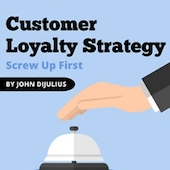 One of the key characteristics of the top customer experience brands in the world is that they are “Zero Risk” to do business with. A Zero Risk business isn’t one that never makes mistakes; every excellent customer service company drops the ball from time to time. The secret to what makes these top brands Zero Risk lies in their customer service training—specifically, how well they have trained their employees to make it right when things do go wrong. In other words, Zero Risk means peace of mind for the customer.
One of the key characteristics of the top customer experience brands in the world is that they are “Zero Risk” to do business with. A Zero Risk business isn’t one that never makes mistakes; every excellent customer service company drops the ball from time to time. The secret to what makes these top brands Zero Risk lies in their customer service training—specifically, how well they have trained their employees to make it right when things do go wrong. In other words, Zero Risk means peace of mind for the customer.
A lot of organizations force their customer-facing employees to hide behind company policy. Policy is a word that tends to create a negative experience. During customer interactions, customers hate hearing the words, “Our policy is . . .”. They understand policy was created to protect the organization from being taken advantage of by the customer.
Take an objective look at your rules of customer engagement and stop punishing 98% of customers for what only 2% do. Instead, train your employees to have a charitable assumption, which means giving customers the benefit of the doubt. In addition to being the right thing to do, it is a fantastic business strategy for building customer loyalty and enhancing customer lifetime.
A BRILLIANT COMEBACK: PROVEN MARKETING STRATEGY FOR GROWTH AND CUSTOMER RETENTION
When a problem arises with a customer, it gives us the opportunity to own that customer for life.
Brand loyalty often results from screw-ups, i.e., how well a company handled a situation that initially went wrong. It is a fact that a high percentage of customers will do more business with a brand after a positive resolution was made to a problem. This is known as the Service Recovery Paradox, which is where the customer actually becomes more loyal to the brand than if the initial mistake had never occurred. It may sound counterintuitive, but the handling of problems can and should be part of your customer retention strategy. An unhappy customer quickly moves on. A happy customer is a loyal customer. And with acquisition five times more costly than merely keeping customers around, a healthy customer retention rate is very good for your bottom line.
It’s a proven fact that customers can often be more loyal to your business after they have experienced a service failure than if it had never happened in the first place. If your business deals with it well, you will clearly see the positive effect of customer satisfaction on loyalty growth.
In fact, new research from Stella Connect supports this. It was discovered that 97% of consumers across the United States and United Kingdom say that if a brand turned a poor customer service experience into a positive one by solving their problems immediately, they would do business with that brand again.
LEGENDARY EXAMPLES OF BUSINESSES EXPERIENCING HIGH CUSTOMER SATISFACTION
Being Zero Risk also tends to create heroic, legendary stories about your business that get shared amongst employees, with customers, and on social media. For example, I have worked with the Ritz-Carlton hotels and have heard numerous epic tales such as this: When a guest tried to check in upon arrival and their room wasn’t available and the hotel was fully booked, a Ritz-Carlton team member booked and paid for that guest’s hotel room at their nearest competitor.
This clearly went far beyond the average customer experience. No company can make customers happy 100% of the time—there is no mobile app for that. But greatly exceeding customer expectations can be part of every company’s marketing strategy and business model. Putting guests’ needs first, always, is a sure way to not only build a strong customer base but also to greatly reduce churn rates.
Another great example of brilliant service recovery is found in the Starbucks customer service experience, which allows baristas to go the extra mile. Baristas are trained to provide a card to inconvenienced current customers that says:
We apologize if your Starbucks experience was anything but wonderful. The next time we see you, please enjoy a beverage on us.
With every complimentary beverage, customer relationships are strengthened in real time. Such personalized experience—a reflection of the company’s customer service vision statement—leads to the right kind of customer feedback and enriches the customer life cycle.
TAKE THESE STEPS FOR BUILDING A ZERO RISK BRAND WITH STRONG CUSTOMER LIFETIME
To build a Zero Risk brand, you need to realize where you drop the ball the most, implement systems that reduce occurrences of those service defects, and create corrective protocols. Then, train your employees on these protocols to make things right.
Organizations can achieve greatness when their employees are allowed to do unexpected things—to show initiative and creativity, to step outside the scripted path. That is when the most delightful, interesting, and amazing results occur.
John DiJulius, best-selling author of five customer service books, is the chief revolution officer of The DiJulius Group and works with the top brands in the world on customer and employee experience.

